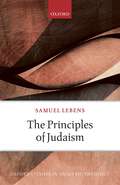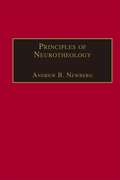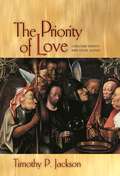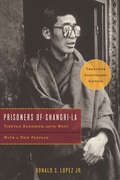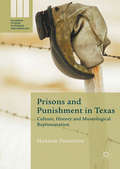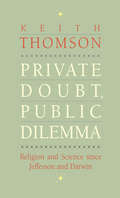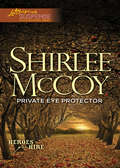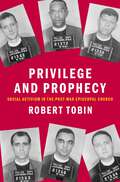- Table View
- List View
The Principles of Judaism (Oxford Studies in Analytic Theology)
by Samuel LebensSamuel Lebens takes the three principles of Jewish faith, as proposed by Rabbi Joseph Albo (1380-1444), in order to scrutinize and refine them with the toolkit of contemporary analytic philosophy. What could it mean for a perfect being to create a world from nothing? Could our world be anything more than a figment of God's imagination? What is the Torah? What does Judaism expect from a Messiah, and what would it mean for a world to be redeemed? These questions are explored in conversation with a wide array of Jewish sources and with an eye towards diverse fields of contemporary research, such as cosmology, philosophical logic, the ontology of literature, and the metaphysics of time. The Principles of Judaism articulates the most fundamental axioms of Orthodox Judaism in the vernacular of contemporary philosophy.
Principles of Neurotheology (Routledge Science and Religion Series)
by Andrew B. NewbergFirst Published in 2017. Neurotheology has garnered substantial attention in the academic and lay communities in recent years. Several books have been written addressing the relationship between the brain and religious experience and numerous scholarly articles have been published on the topic, some in the popular press. The scientific and religious communities have been very interested in obtaining more information regarding neurotheology, how to approach this topic, and how science and religion can be integrated in some manner that preserves both. If neurotheology is to be considered a viable field going forward, it requires a set of clear principles that can be generally agreed upon and supported by both the theological or religious perspective and the scientific one as well. Principles of Neurotheology sets out the necessary principles of neurotheology which can be used as a foundation for future neurotheological discourse. Laying the groundwork for a new synthesis of scientific and theological dialogue, this book proposes that neurotheology, a term fraught with potential problems, is a highly useful and important voice in the greater study of religious and theological ideas and their intersection with science.
Principles of Neurotheology (Routledge Science and Religion Series)
by Andrew B. NewbergFirst Published in 2017. Neurotheology has garnered substantial attention in the academic and lay communities in recent years. Several books have been written addressing the relationship between the brain and religious experience and numerous scholarly articles have been published on the topic, some in the popular press. The scientific and religious communities have been very interested in obtaining more information regarding neurotheology, how to approach this topic, and how science and religion can be integrated in some manner that preserves both. If neurotheology is to be considered a viable field going forward, it requires a set of clear principles that can be generally agreed upon and supported by both the theological or religious perspective and the scientific one as well. Principles of Neurotheology sets out the necessary principles of neurotheology which can be used as a foundation for future neurotheological discourse. Laying the groundwork for a new synthesis of scientific and theological dialogue, this book proposes that neurotheology, a term fraught with potential problems, is a highly useful and important voice in the greater study of religious and theological ideas and their intersection with science.
Print and the Urdu Public: Muslims, Newspapers, and Urban Life in Colonial India
by Megan Eaton RobbIn early twentieth century British India, prior to the arrival of digital medias and after the rise of nationalist political movements, a small-town paper from the margins of society became a key player in Urdu journalism. Published in the isolated market town of Bijnor, Madinah grew to hold influence across North India and the Punjab while navigating complex issues of religious and political identity. In Print and the Urdu Public, Megan Robb uses the previously unexamined perspective of the Madinah to consider Urdu print publics and urban life in South Asia. Through a discursive and material analysis of Madinah, the book explores how Muslims who had settled in ancestral qasbahs, or small towns, used newspapers to facilitate a new public consciousness. The book demonstrates how Madinah connected the Urdu newspaper conversation both explicitly and implicitly with Muslim identity and delineated the boundaries of a Muslim public conversation in a way that emphasized rootedness to local politics and small urban spaces. The case study of this influential but understudied newspaper reveals how a network of journalists with substantial ties to qasbahs produced a discourse self-consciously alternative to the Western-influenced, secularized cities. Megan Robb augments the analysis with evidence from contemporary Urdu, English, and Hindi papers, government records, private diaries, private library holdings, ethnographic interviews, and training materials for newspaper printers. This thoroughly researched volume recovers the erasure of qasbah voices and proclaims the importance of space and time in definitions of the public sphere in South Asia. Print and the Urdu Public demonstrates how an Urdu newspaper published from the margins became central to the Muslim public constituted in the first half of the twentieth century.
Print and the Urdu Public: Muslims, Newspapers, and Urban Life in Colonial India
by Megan Eaton RobbIn early twentieth century British India, prior to the arrival of digital medias and after the rise of nationalist political movements, a small-town paper from the margins of society became a key player in Urdu journalism. Published in the isolated market town of Bijnor, Madinah grew to hold influence across North India and the Punjab while navigating complex issues of religious and political identity. In Print and the Urdu Public, Megan Robb uses the previously unexamined perspective of the Madinah to consider Urdu print publics and urban life in South Asia. Through a discursive and material analysis of Madinah, the book explores how Muslims who had settled in ancestral qasbahs, or small towns, used newspapers to facilitate a new public consciousness. The book demonstrates how Madinah connected the Urdu newspaper conversation both explicitly and implicitly with Muslim identity and delineated the boundaries of a Muslim public conversation in a way that emphasized rootedness to local politics and small urban spaces. The case study of this influential but understudied newspaper reveals how a network of journalists with substantial ties to qasbahs produced a discourse self-consciously alternative to the Western-influenced, secularized cities. Megan Robb augments the analysis with evidence from contemporary Urdu, English, and Hindi papers, government records, private diaries, private library holdings, ethnographic interviews, and training materials for newspaper printers. This thoroughly researched volume recovers the erasure of qasbah voices and proclaims the importance of space and time in definitions of the public sphere in South Asia. Print and the Urdu Public demonstrates how an Urdu newspaper published from the margins became central to the Muslim public constituted in the first half of the twentieth century.
Printing and Prophecy: Prognostication and Media Change 1450-1550 (Cultures Of Knowledge In The Early Modern World)
by Jonathan GreenPrinting and Prophecy: Prognostication and Media Change 1450-1550 examines prognostic traditions and late medieval prophetic texts in the first century of printing and their effect on the new medium of print. The many prophetic and prognostic works that followed Europe's earliest known printed book---not the Gutenberg Bible, but the Sibyl's Prophecy, printed by Gutenberg two years earlier and known today only from a single page---over the next century were perennial best sellers for many printers, and they provide the modern observer with a unique way to study the history and inner workings of the print medium. The very popularity of these works, often published as affordable booklets, raised fears of social unrest. Printers therefore had to meet customer demand while at the same time channeling readers' reactions along approved paths. Authors were packaged---and packaged themselves---in word and image to respond to the tension, while leading figures of early modern culture such as Paracelsus, Martin Luther, and Sebastian Brant used printed prophecies for their own purposes in a rapidly changing society. Based on a wide reading of many sources, Printing and Prophecy contributes to the study of early modern literature, including how print changed the relationship among authors, readers, and texts. The prophetic and astrological texts the book examines document changes in early modern society that are particularly relevant to German studies and are key texts for understanding the development of science, religion, and popular culture in the early modern period. By combining the methods of cultural studies and book history, this volume brings a new perspective to the study of Gutenberg and later printers.
The Priority of Love: Christian Charity and Social Justice (New Forum Books #57)
by Timothy P. JacksonThis book explores the relation between agape (or Christian charity) and social justice. Timothy Jackson defines agape as the central virtue in Christian ethical thought and action and applies his insights to three concrete issues: political violence, forgiveness, and abortion. Taking his primary cue from the New Testament while drawing extensively from contemporary theology and philosophy, Jackson identifies three features of Christian charity: unconditional commitment to the good of others, equal regard for others' well-being, and passionate service open to self-sacrifice for the sake of others.Charity, prescribed by Jesus for his disciples and named by Saint Paul as the "greatest" theological virtue, is contrasted with various accounts of justice. Jackson argues that agape is not trumped by justice or other goods. Rather, agape precedes justice: without the work of love, society would not produce persons capable of merit, demerit, and contract, the elements of most modern conceptions of justice. Jackson then considers the implications of his ideas for several questions: the nature of God, the relation between Christian love and political violence, the place of forgiveness, and the morality of abortion. Arguing that agapic love is to be construed as a gift of grace as well as a divine commandment, Jackson concludes that love is the "eternal life" that makes temporal existence possible and thus the "first" Christian virtue. Though foremost a contribution to Christian ethics, Jackson's arguments and the issues he takes up will find a broader readership.
The Prism and the Rainbow: A Christian Explains Why Evolution Is Not a Threat
by Joel W. MartinGod or Darwin? It is one of the most contentious conflicts of our time. It is also completely unnecessary, according to Joel W. Martin, an evolutionary biologist and ordained elder in the Presbyterian Church USA. In this slim but powerful book, Martin argues that it is not contradictory to be a practicing, faithful Christian who accepts the science of evolution. Martin finds that much of the controversy in the United States over evolution is manufactured and predicated on a complete—and sometimes willful—misapprehension of basic science. Science and religion, he says, serve different purposes and each seeks to answer questions that the other need never address. He believes that many of the polarizing debates about evolution distract from the deeper lessons of Christianity and that literal, fundamentalist readings of the Bible require the faithful to reject not just evolution but many of science's greatest discoveries.Just as the scientific explanation of rainbows is not meant to refute the biblical "rainbow" story of God’s promise, evolutionary theory is not a ploy to disavow the divine. Indeed, Martin shows that the majority of Christians worldwide accept the theory of evolution. He urges his fellow Christians to refuse to participate in the intellectually stifling debate over evolution and creationism/intelligent design.
The Prison Boundary: Between Society and Carceral Space (Palgrave Studies in Prisons and Penology)
by Jennifer TurnerThis book explores the idea of the prison boundary, identifying where it is located, which processes and performances help construct and animate it, and who takes part in them. Although the relationship between prison and non-prison has garnered academic interest from various disciplines in the last decade, the cultural performance of the boundary has been largely ignored. This book adds to the field by exploring the complexity of the material and symbolic connections that exist between society and carceral space. Drawing on a range of cultural examples including governmental legislation, penal tourism, prisoner work programmes and art by offenders, Jennifer Turner attends to the everyday, practised manifestations and negotiations of the prison boundary. The book reveals how prisoners actively engage with life outside of prison and how members of the public may cross the boundary to the inside. In doing so, it shows the prison boundary to be a complex patchwork of processes, people and parts. The book will be of great interest to scholars and upper-level students of criminology, carceral geography and cultural studies.
Prison Gangs Behind Bars and Beyond: A Vicious Game (Palgrave Studies in Risk, Crime and Society)
by Dev Rup MaitraThis book draws on a four-year ethnographic study conducted in the prisons and on the streets of Greater Manchester, England, to examine gangs and organised crime in the North of England. It includes the personal testimonies of active prison gang members and major organised crime figures, many of whom are behind bars, and some active street gang members. It presents an holistic account by exploring the linkages that exist between prisons and the streets, including the lines of continuity between gangs on both sides of the prison walls and how gang affiliation straddles this divide. It offers data on the region’s drug market (specifically Class A drugs) as this market is the lynchpin of the underworld, both within and without prison. It also includes the perspectives and insights of prison officers, police detectives, youth workers, active and former street gang members and the parents of deceased gang members. This is a ground-breaking, contemporary study, analysing English gang compositions and activities, with its findings and results based on qualitative interviews and ethnographic research.
The Prison Narratives of Jeanne Guyon (AAR Religions in Translation)
by Ronney Mourad Dianne Guenin-LelleThis book presents the first-ever English translation of the Prison Narratives written by the seventeenth-century French mystic and Quietist, Jeanne Guyon (1648-1717). Although she was marginalized and ignored by French historians for two centuries after her death, Guyon became a major figure in the development of transatlantic Protestant spirituality in the eighteenth century, and her writings have remained popular among English-speaking audiences. Guyon's narrative describes her confinement between 1695 and 1703 in various prisons, including the dreaded Bastille. It also maps, in moving and unforgettable detail, the political and religious hegemony that sought to destroy her reputation and erase her from history. Although she published an autobiography in 1720, Guyon kept the part that described her experience in prison private and the text remained undiscovered for almost three centuries - until an archival version was found and published in 1992 under the title Récits de Captivité (Prison Narratives). Mourad and Guenin-Lelle provide here not only a translation of the full Narratives but a thorough introduction, including a brief biography of Guyon, an analysis of the Quietist Affair (the religious and political conflict responsible for her persecution), and a summary of the key historical, literary, and theological aspects of Guyon's prison writings. The introduction represents the most detailed examination of the Prison Narratives presently available in either English or French.
Prison Religion: Faith-Based Reform and the Constitution
by Winnifred Fallers SullivanMore than the citizens of most countries, Americans are either religious or in jail--or both. But what does it mean when imprisonment and evangelization actually go hand in hand, or at least appear to? What do "faith-based" prison programs mean for the constitutional separation of church and state, particularly when prisoners who participate get special privileges? In Prison Religion, law and religion scholar Winnifred Fallers Sullivan takes up these and other important questions through a close examination of a 2005 lawsuit challenging the constitutionality of a faith-based residential rehabilitation program in an Iowa state prison. Americans United for the Separation of Church and State v. Prison Fellowship Ministries, a trial in which Sullivan served as an expert witness, centered on the constitutionality of allowing religious organizations to operate programs in state-run facilities. Using the trial as a case study, Sullivan argues that separation of church and state is no longer possible. Religious authority has shifted from institutions to individuals, making it difficult to define religion, let alone disentangle it from the state. Prison Religion casts new light on church-state law, the debate over government-funded faith-based programs, and the predicament of prisoners who have precious little choice about what kind of rehabilitation they receive, if they are offered any at all.
Prison Religion: Faith-Based Reform and the Constitution
by Winnifred Fallers SullivanMore than the citizens of most countries, Americans are either religious or in jail--or both. But what does it mean when imprisonment and evangelization actually go hand in hand, or at least appear to? What do "faith-based" prison programs mean for the constitutional separation of church and state, particularly when prisoners who participate get special privileges? In Prison Religion, law and religion scholar Winnifred Fallers Sullivan takes up these and other important questions through a close examination of a 2005 lawsuit challenging the constitutionality of a faith-based residential rehabilitation program in an Iowa state prison. Americans United for the Separation of Church and State v. Prison Fellowship Ministries, a trial in which Sullivan served as an expert witness, centered on the constitutionality of allowing religious organizations to operate programs in state-run facilities. Using the trial as a case study, Sullivan argues that separation of church and state is no longer possible. Religious authority has shifted from institutions to individuals, making it difficult to define religion, let alone disentangle it from the state. Prison Religion casts new light on church-state law, the debate over government-funded faith-based programs, and the predicament of prisoners who have precious little choice about what kind of rehabilitation they receive, if they are offered any at all.
Prisoners of Shangri-La: Tibetan Buddhism and the West
by Donald S. Lopez Jr.To the Western imagination, Tibet evokes exoticism, mysticism, and wonder: a fabled land removed from the grinding onslaught of modernity, spiritually endowed with all that the West has lost. Originally published in 1998, Prisoners of Shangri-La provided the first cultural history of the strange encounter between Tibetan Buddhism and the West. Donald Lopez reveals here fanciful misconceptions of Tibetan life and religion. He examines, among much else, the politics of the term “Lamaism,” a pejorative synonym for Tibetan Buddhism; the various theosophical, psychedelic, and New Age purposes served by the so-called Tibetan Book of the Dead; and the unexpected history of the most famous of all Tibetan mantras, om mani padme hum. More than pop-culture anomalies, these versions of Tibet are often embedded in scholarly sources, constituting an odd union of the popular and the academic, of fancy and fact. Upon its original publication, Prisoners of Shangri-La sent shockwaves through the field of Tibetan studies—hailed as a timely, provocative, and courageous critique. Twenty years hence, the situation in Tibet has only grown more troubled and complex—with the unrest of 2008, the demolition of the dwellings of thousands of monks and nuns at Larung Gar in 2016, and the scores of self-immolations committed by Tibetans to protest the Dalai Lama’s exile. In his new preface to this anniversary edition, Lopez returns to the metaphors of prison and paradise to illuminate the state of Tibetan Buddhism—both in exile and in Tibet—as monks and nuns still seek to find a way home. Prisoners of Shangri-La remains a timely and vital inquiry into Western fantasies of Tibet.
Prisoners of Shangri-La: Tibetan Buddhism and the West
by Donald S. Lopez Jr.To the Western imagination, Tibet evokes exoticism, mysticism, and wonder: a fabled land removed from the grinding onslaught of modernity, spiritually endowed with all that the West has lost. Originally published in 1998, Prisoners of Shangri-La provided the first cultural history of the strange encounter between Tibetan Buddhism and the West. Donald Lopez reveals here fanciful misconceptions of Tibetan life and religion. He examines, among much else, the politics of the term “Lamaism,” a pejorative synonym for Tibetan Buddhism; the various theosophical, psychedelic, and New Age purposes served by the so-called Tibetan Book of the Dead; and the unexpected history of the most famous of all Tibetan mantras, om mani padme hum. More than pop-culture anomalies, these versions of Tibet are often embedded in scholarly sources, constituting an odd union of the popular and the academic, of fancy and fact. Upon its original publication, Prisoners of Shangri-La sent shockwaves through the field of Tibetan studies—hailed as a timely, provocative, and courageous critique. Twenty years hence, the situation in Tibet has only grown more troubled and complex—with the unrest of 2008, the demolition of the dwellings of thousands of monks and nuns at Larung Gar in 2016, and the scores of self-immolations committed by Tibetans to protest the Dalai Lama’s exile. In his new preface to this anniversary edition, Lopez returns to the metaphors of prison and paradise to illuminate the state of Tibetan Buddhism—both in exile and in Tibet—as monks and nuns still seek to find a way home. Prisoners of Shangri-La remains a timely and vital inquiry into Western fantasies of Tibet.
Prisoners of Shangri-La: Tibetan Buddhism and the West
by Donald S. Lopez Jr.To the Western imagination, Tibet evokes exoticism, mysticism, and wonder: a fabled land removed from the grinding onslaught of modernity, spiritually endowed with all that the West has lost. Originally published in 1998, Prisoners of Shangri-La provided the first cultural history of the strange encounter between Tibetan Buddhism and the West. Donald Lopez reveals here fanciful misconceptions of Tibetan life and religion. He examines, among much else, the politics of the term “Lamaism,” a pejorative synonym for Tibetan Buddhism; the various theosophical, psychedelic, and New Age purposes served by the so-called Tibetan Book of the Dead; and the unexpected history of the most famous of all Tibetan mantras, om mani padme hum. More than pop-culture anomalies, these versions of Tibet are often embedded in scholarly sources, constituting an odd union of the popular and the academic, of fancy and fact. Upon its original publication, Prisoners of Shangri-La sent shockwaves through the field of Tibetan studies—hailed as a timely, provocative, and courageous critique. Twenty years hence, the situation in Tibet has only grown more troubled and complex—with the unrest of 2008, the demolition of the dwellings of thousands of monks and nuns at Larung Gar in 2016, and the scores of self-immolations committed by Tibetans to protest the Dalai Lama’s exile. In his new preface to this anniversary edition, Lopez returns to the metaphors of prison and paradise to illuminate the state of Tibetan Buddhism—both in exile and in Tibet—as monks and nuns still seek to find a way home. Prisoners of Shangri-La remains a timely and vital inquiry into Western fantasies of Tibet.
Prisoners of Shangri-La: Tibetan Buddhism and the West
by Donald S. Lopez Jr.To the Western imagination, Tibet evokes exoticism, mysticism, and wonder: a fabled land removed from the grinding onslaught of modernity, spiritually endowed with all that the West has lost. Originally published in 1998, Prisoners of Shangri-La provided the first cultural history of the strange encounter between Tibetan Buddhism and the West. Donald Lopez reveals here fanciful misconceptions of Tibetan life and religion. He examines, among much else, the politics of the term “Lamaism,” a pejorative synonym for Tibetan Buddhism; the various theosophical, psychedelic, and New Age purposes served by the so-called Tibetan Book of the Dead; and the unexpected history of the most famous of all Tibetan mantras, om mani padme hum. More than pop-culture anomalies, these versions of Tibet are often embedded in scholarly sources, constituting an odd union of the popular and the academic, of fancy and fact. Upon its original publication, Prisoners of Shangri-La sent shockwaves through the field of Tibetan studies—hailed as a timely, provocative, and courageous critique. Twenty years hence, the situation in Tibet has only grown more troubled and complex—with the unrest of 2008, the demolition of the dwellings of thousands of monks and nuns at Larung Gar in 2016, and the scores of self-immolations committed by Tibetans to protest the Dalai Lama’s exile. In his new preface to this anniversary edition, Lopez returns to the metaphors of prison and paradise to illuminate the state of Tibetan Buddhism—both in exile and in Tibet—as monks and nuns still seek to find a way home. Prisoners of Shangri-La remains a timely and vital inquiry into Western fantasies of Tibet.
Prisons and Punishment in Texas: Culture, History and Museological Representation (Palgrave Studies in Prisons and Penology)
by Hannah ThurstonThis book explores the identity of Texas as a state with a large and severe penal system. It does so by assessing the narratives at work in Texas museums and tourist sites associated with prisons and punishment. In such cultural institutions, complex narratives are presented, which show celebratory stories of Texan toughness in the penal sphere, as well as poignant stories about the witnessing of executions, comical stories that normalize the harsher aspects of Texan punishment, and presentations about prison officers who have lost their lives in the war on crime. In analysing these representations, the book shows that Texan history plays an important role in the production of Texan self-identity, and that to understand the Texan commitment to harsh punishment we must be prepared to focus on Texan myths and memories. Prisons and Punishment in Texas draws on diverse interdisciplinary work, including criminology, cultural studies about Southern values, as well as research on cultural memory and dark tourism. Museums are shown to be under-researched sites of criminological significance, which offer rich evidence through which penal imaginaries and the cultural role of punishment can be explored. The book will be of great interest to criminologists as well as scholars of sociology, cultural studies, museum studies and politics.
Private Doubt, Public Dilemma: Religion and Science since Jefferson and Darwin (The Terry Lectures Series)
by Keith Stewart ThomsonEach age has its own crisis—our modern experience of science-religion conflict is not so very different from that experienced by our forebears, Keith Thomson proposes in this thoughtful book. He considers the ideas and writings of Thomas Jefferson and Charles Darwin, two men who struggled mightily to reconcile their religion and their science, then looks to more recent times when scientific challenges to religion (evolutionary theory, for example) have given rise to powerful political responses from religious believers. Today as in the eighteenth century, there are pressing reasons for members on each side of the religion-science debates to find common ground, Thomson contends. No precedent exists for shaping a response to issues like cloning or stem cell research, unheard of fifty years ago, and thus the opportunity arises for all sides to cooperate in creating a new ethics for the common good.
Private Eye Protector (Heroes for Hire #5)
by Shirlee McCoyIF ONLY SHE COULD REMEMBER After an accident, single mother Rayne Sampson loses her recent memories. Thankfully, her sweet baby girl is front and center in her mind—but so is the terrifying image of a dangerous man. Someone with terrible intent is after her. Private investigator Chance Richardson assures her she’s safe.
Privilege and Prophecy: Social Activism in the Post-War Episcopal Church
by Robert TobinThe Episcopal Church has long been regarded as the religion of choice among America's ruling elite, helping to set the tone for the moral and social life of the nation during the twentieth century. Shaped by their experiences of the Great Depression and World War II, a new generation of Episcopal leaders emerged after 1945, eager to place their church in the vanguard of social reform and reconciliation. These liberal activists came to dominate the church's national structures during the 1960s and shaped its response to the civil rights and anti-war movements. They sought to reposition the Episcopal Church as a catalyst for progressive change. Even so, these leaders routinely neglected black, female, and working-class Episcopalians, even as they espoused the causes of equality and liberation in the wider society. This study focuses on forms of social activism and theological innovation pursued by members of the war generation. Attending to the development of such activities among the WASP elite provides crucial insight into their underlying assumptions about social and theological authority and helps explain their ambivalent response to the challenges faced in the 1960s and 1970s. Drawing upon extensive archival research, this book not only offers a group portrait of Episcopalianism's leading post-war figures but documents the ways in which their individual pursuits influenced the direction of the church as a whole.
Privilege and Prophecy: Social Activism in the Post-War Episcopal Church
by Robert TobinThe Episcopal Church has long been regarded as the religion of choice among America's ruling elite, helping to set the tone for the moral and social life of the nation during the twentieth century. Shaped by their experiences of the Great Depression and World War II, a new generation of Episcopal leaders emerged after 1945, eager to place their church in the vanguard of social reform and reconciliation. These liberal activists came to dominate the church's national structures during the 1960s and shaped its response to the civil rights and anti-war movements. They sought to reposition the Episcopal Church as a catalyst for progressive change. Even so, these leaders routinely neglected black, female, and working-class Episcopalians, even as they espoused the causes of equality and liberation in the wider society. This study focuses on forms of social activism and theological innovation pursued by members of the war generation. Attending to the development of such activities among the WASP elite provides crucial insight into their underlying assumptions about social and theological authority and helps explain their ambivalent response to the challenges faced in the 1960s and 1970s. Drawing upon extensive archival research, this book not only offers a group portrait of Episcopalianism's leading post-war figures but documents the ways in which their individual pursuits influenced the direction of the church as a whole.
The Privilege of Being Banal: Art, Secularism, and Catholicism in Paris (Class 200: New Studies in Religion)
by Elayne OliphantFrance, officially, is a secular nation. Yet Catholicism is undeniably a monumental presence, defining the temporal and spatial rhythms of Paris. At the same time, it often fades into the background as nothing more than “heritage.” In a creative inversion, Elayne Oliphant asks in The Privilege of Being Banal what, exactly, is hiding in plain sight? Could the banality of Catholicism actually be a kind of hidden power? Exploring the violent histories and alternate trajectories effaced through this banal backgrounding of a crucial aspect of French history and culture, this richly textured ethnography lays bare the profound nostalgia that undergirds Catholicism’s circulation in nonreligious sites such as museums, corporate spaces, and political debates. Oliphant’s aim is to unravel the contradictions of religion and secularism and, in the process, show how aesthetics and politics come together in contemporary France to foster the kind of banality that Hannah Arendt warned against: the incapacity to take on another person’s experience of the world. A creative meditation on the power of the taken-for-granted, The Privilege of Being Banal is a landmark study of religion, aesthetics, and public space.
The Privilege of Being Banal: Art, Secularism, and Catholicism in Paris (Class 200: New Studies in Religion)
by Elayne OliphantFrance, officially, is a secular nation. Yet Catholicism is undeniably a monumental presence, defining the temporal and spatial rhythms of Paris. At the same time, it often fades into the background as nothing more than “heritage.” In a creative inversion, Elayne Oliphant asks in The Privilege of Being Banal what, exactly, is hiding in plain sight? Could the banality of Catholicism actually be a kind of hidden power? Exploring the violent histories and alternate trajectories effaced through this banal backgrounding of a crucial aspect of French history and culture, this richly textured ethnography lays bare the profound nostalgia that undergirds Catholicism’s circulation in nonreligious sites such as museums, corporate spaces, and political debates. Oliphant’s aim is to unravel the contradictions of religion and secularism and, in the process, show how aesthetics and politics come together in contemporary France to foster the kind of banality that Hannah Arendt warned against: the incapacity to take on another person’s experience of the world. A creative meditation on the power of the taken-for-granted, The Privilege of Being Banal is a landmark study of religion, aesthetics, and public space.
The Privilege of Man: A Theme in Judaism, Islam and Christianity (Religious Studies: Bloomsbury Academic Collections)
by Kenneth CraggThis book is based on the 1967 Jordan Lectures in Comparative Religion and discusses the Biblical concept of human dominion and the Qur'anic doctrine of Adam as caliph. It explores the Jewish, Muslim and Christian understanding of man in election, the prophet-state and in grace and sonship.
